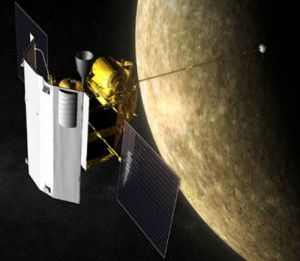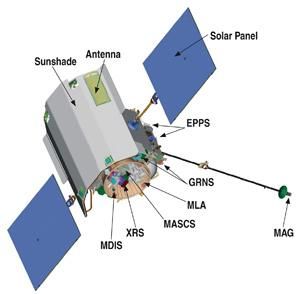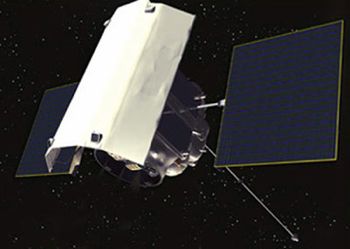
Home - Search - Browse - Alphabetic Index: 0- 1- 2- 3- 4- 5- 6- 7- 8- 9
A- B- C- D- E- F- G- H- I- J- K- L- M- N- O- P- Q- R- S- T- U- V- W- X- Y- Z
Messenger
 Messenger |
AKA: MErcury Surface, Space ENvironment, GEochemistry and Ranging mission. Status: Operational 2004. First Launch: 2004-08-03. Last Launch: 2004-08-03. Number: 1 . Payload: 50 kg (110 lb). Thrust: 666 N (149 lbf). Gross mass: 1,100 kg (2,400 lb). Unfuelled mass: 500 kg (1,100 lb). Specific impulse: 290 s.
To achieve Mercury orbit using a conventional liquid rocket engine meant a seven year flight. During that time Messenger would make six flybys of Earth, Venus, and Mercury to lower the aphelion of its solar orbit and minimize the needed final engine burn to place the spacecraft into Mercury orbit. Even with these planetary gravitational assists, 55% of Messenger's launch mass was rocket propellant, and the scientific payload amounted to less than 5% of its launch mass.
Spacecraft description
To minimize empty mass, Messenger's structure was primarily composed of graphite epoxy material and its dual-mode, liquid chemical propulsion system was integrated into the spacecraft's structure. Two solar panels, charging a nickel-hydrogen battery, provided power. Due to the intense sunlight at Mercury, the panels were mirrored to reflect away 67% of the sunlight.
Redundant integrated electronics modules controlled the spacecraft, each with two processors -- a 25 MHz main processor and a 10-MHz fault-protection processor. Attitude was determined using star-tracking cameras and an Inertial Measurement Unit. Six Digital Solar Sensors provided a backup. Attitude control was accomplished using four reaction wheels. Messenger's 16 small thrusters were available if needed as a back-up or for coarse maneuvers. Communications was through circularly polarized X-band phased-array antennas. A conventional dish antenna could not be used due to the temperatures at Mercury.
For heat protection at Mercury, where the Sun was 11 times brighter than Earth, a sunshade made of heat-resistant ceramic cloth was used. At Mercury the sunshield would reach 370 deg C, while keeping the spacecraft below 20 deg C.
Scientific Payload - the demanding mission meant a net scientific payload of only 50 kg, less than 5% of the spacecraft mass. Nevertheless the miniaturized instrument suite included:
- Mercury Dual Imaging System (MDIS): This instrument consisted of wide-angle and narrow-angle imagers. A pivot platform was used for pointing.
- Gamma-Ray and Neutron Spectrometer (GRNS): This instrument was to detect gamma rays and neutrons emitted by Mercury's surface. It was to be used to map the relative abundances of different elements and was to determine if there was ice at Mercury's poles
- X-Ray spectrometer (XRS): XRS was to detect these X-rays emitted by the surface and measure the abundances of various elements in Mercury's crust.
- Magnetometer (MAG): This instrument was at the end of a 3.6 meter boom, and was to map Mercury's magnetic field and was to search for magnetized rocks in the crust.
- Mercury Laser Altimeter (MLA): This instrument was to map Mercury's topography with high accuracy.
- Mercury Atmospheric and Surface Composition Spectrometer (MASCS): This spectrometer was sensitive to light from the infrared to the ultraviolet and was to measure the abundances of atmospheric gases, as well as detect minerals on the surface.
- Energetic Particle and Plasma Spectrometer (EPPS): EPPS measured the composition, distribution, and energy of charged particles in Mercury's magnetosphere.
- Radio Science (RS): RS experiment used the Doppler effect to measure very slight changes in the spacecraft's velocity as it orbited Mercury. This was to allow scientists to study Mercury's mass distribution, including variations in the thickness of its crust.
Messenger was to use gravity assists from Earth, Venus and Mercury to lower its speed relative to Mercury at orbit insertion. It would flyby Earth in August 2005, then Venus twice, in October 2006 and June 2007. Three Mercury flybys, in January 2008, October 2008 and September 2009, would each be followed two months later by a course correction maneuver by Messenger's engine. The flybys would be used to map most of the planet and measure the composition of the surface, atmosphere and magnetosphere.
In a final encounter with the planet in March 2011. 33% of the spacecraft's propellant would be used to make a maneuver of 0.83 km/sec, putting the spacecraft into a near-polar 200 kilometer x 15,193 kilometer 12-hour orbit inclined 80 deg to Mercury's equator. The perigee was over the northern hemisphere to allow Messenger to conduct a detailed investigation of Mercury's geology and composition of the Caloris impact basin. The orbit was to be maintained by small engine corrections every 88 days (Mercury year) until the one earth-year survey of the planet was completed in March 2012.
RCS Coarse No x Thrust: 16 thrusters. Spacecraft delta v: 2,300 m/s (7,500 ft/sec).
NASA NSSDC Master Catalog Description
The Mercury Surface, Space Environment, Geochemistry and Ranging (MESSENGER) mission is designed to study the characteristics and environment of Mercury from orbit. Specifically, the scientific objectives of the mission are to characterize the chemical composition of Mercury's surface, the geologic history, the nature of the magnetic field, the size and state of the core, the volatile inventory at the poles, and the nature of Mercury's exosphere and magnetosphere over a nominal orbital mission of one Earth year.
Mission Profile
MESSENGER launched on 3 August 2004 at 6:15:56 UT (2:15:56 a.m. EDT) on a Delta 7925H (a Delta II Heavy launch vehicle with nine strap-on solid-rocket boosters). The spacecraft was injected into solar orbit 57 minutes later. The solar panels were then deployed and the spacecraft began sending data on its status.
One year after launch, on 2 August 2005, MESSENGER flew by Earth at an altitude of 2347 km. On 12 December 2005 at 11:30 UT, MESSENGER fired its large thruster for 524 seconds, changing the spacecraft velocity by 316 m/s and putting it on course for its 24 October 2006 Venus flyby at an altitude of 2990 km. The second Venus flyby took place on 5 June 2007 at 23:08 UT (7:08 p.m. EDT) at an altitude of approximately 337 km. The first of three Mercury flybys, all at roughly 200 km altitude, occurred on 14 January 2008 at 19:04 :39 UT, and the second on 6 October 2008 at 08:40:22 UT. The third took place on 29 September 2009 at 21:54:58 UT at a distance of 228 km. There were also five deep space manuevers. Data collected during the Mercury flybys was used to help plan the scientific campaign during the orbital phase.
Mercury orbit insertion took place with a 15 minute burn starting at 00:45 UT on 18 March 2011 (8:45 p.m. 17 March EDT) requiring a delta-V of 0.862 km/s. Science observations began on April 4 at 20:40 UT (4:40 p.m. EDT). The nominal orbit had a periapsis of 200 km at 60 degrees N latitude, an apoapsis of 15,193 km, a period of 12 hours and an inclination of 80 degrees. The periapsis slowly rose due to solar perturbations to over 400 km at the end of 88 days (one Mercury year) at which point it was readjusted to a 200 km, 12 hour orbit via a two burn sequence.
Data was collected from orbit for one Earth year, the end of the primary mission was in March 2012. Extensions to the mission allowed the spacecraft to operate for an additional 3 years until the propellant necessary to maintain its orbit was exhausted. The MESSENGER spacecraft impacted the surface of Mercury as planned on 30 April 2015 at 19:26 UT (3:26 p.m. EDT).
Global stereo image coverage at 250 m/pixel resolution was completed. The mission has also yielded global composition maps, a 3-D model of Mercury's magnetosphere, topographic profiles of the northern hemisphere, gravity field, altitude profiles of elemental species, and a characterization of the volatiles in permanently shadowed craters at the poles.
Spacecraft and Subsystems
The MESSENGER spacecraft is a squat box (1.27 m x 1.42 m x 1.85 m) with a semi-cylindrical thermal shade (roughly 2.5 meters tall and 2 meters wide) for protection from the Sun and two solar panel wings extending radially about 6 meters from tip to tip. A 3.6 m magnetometer boom also extends from the craft. The total mass of the spacecraft is 1093 kg, 607.8 kg of this is propellant and helium. The structure is primarily graphite-cyanate-ester (GrCE) composite and consists of two vertical panels which support two large fuel tanks and two vertical panels which support the oxidizer tank and plumbing panel. The four vertical panels make up the center column and are bolted at their aft ends to an aluminum adapter. A single top deck panel mounts the LVA (large velocity adjust) thruster, small thrusters, helium and auxiliary fuel tanks, star trackers and battery.
Main propulsion is via the 645-N, 317-s bipropellant LVA thruster, four 22-N monopropellant thrusters provide spacecraft steering during main thruster burns, and ten 4-N monopropellant thrusters are used for attitude control. There is also a reaction-wheel attitude control system. Knowledge for attitude control is provided by star tracking cameras, an inertial measurement unit, and six solar sensors. Power is provided by the solar panels, which extend beyond the sunshade and are rotatable to balance panel temperature and power generation, which provides a nominal 450 W in Mercury orbit. The panels are 70% optical solar reflectors and 30% GaAs/Ge cells. The power is stored in a common-pressure-vessel nickel-hydrogen battery, with 11 vessels and 2 cells per vessel.
Communications are in X-band with downlink through two fixed phased-array antenna clusters and uplink and downlink through medium- and low-gain antennas on the forward and aft sides of the spacecraft. Passive thermal control, primarily a fixed opaque ceramic cloth sunshade, is utilized to maintain operating temperatures near the Sun. Radiators are built into the structure and the orbit is optimized to minimize infrared and visible light heating of the spacecraft from the surface of Mercury. Multilayer insulation, low conductivity couplings, and heaters are also used to maintain temperatures within operating limits.
Five science instruments are mounted externally on the bottom deck of the main body: the Mercury Dual Imaging System (MDIS), Gamma-Ray and Neutron Spectrometer (GRNS), X-ray Spectrometer (XRS), Mercury Laser Altimeter (MLA), and Atmospheric and Surface Composition Spectrometer (MASCS). The Energetic Particle and Plasma Spectrometer (EPPS) is mounted on the side and top deck and the magnetometer (MAG) is at the end of the 3.6 m boom. Radio Science (RS) experiments will use the existing communications system.
More at: Messenger.
Family: Mercury probe. Country: USA. Engines: LEROS-1B. Spacecraft: Mercury. Launch Vehicles: Thor, Delta, Delta 7925, Delta 7925H. Propellants: N2O4/MMH. Projects: Discovery series. Launch Sites: Cape Canaveral, Cape Canaveral LC17B. Agency: NASA, APL. Bibliography: 2, 3955, 3956, 6700, 12822.
 | Messenger |
 | Messenger Credit: Manufacturer Image |
2004 August 3 - . 06:15 GMT - . Launch Site: Cape Canaveral. Launch Complex: Cape Canaveral LC17B. Launch Pad: SLC17B. LV Family: Thor. Launch Vehicle: Delta 7925H.
- Messenger - .
Payload: Discovery 8. Mass: 1,066 kg (2,350 lb). Nation: USA.
Agency: NASA.
Manufacturer: APL.
Program: Discovery series.
Class: Mercury.
Type: Mercury probe. Spacecraft: Messenger.
USAF Sat Cat: 28391 . COSPAR: 2004-030A. Apogee: 0 km (0 mi). Perigee: 0 km (0 mi). Inclination: 0.00 deg. Period: 0.00 min.
The NASA Messenger probe to Mercury was was first placed into a parking orbit. The Delta booster second stage's second burn raised the orbit, then the PAM-D solid motor burned to put the probe on an escape trajectory into a 0.92 x 1.08 AU x 6.4 deg heliocentric orbit. Messenger (Mercury Surface, Space Environment, Geochemistry and Ranging) was to make an Earth flyby on August 1, 2005; Venus flybys in 2006 and 2007; and Mercury encounters in January and October 2008 , September 2009 and March 2011 . On this last encounter the Aerojet 660N engine was to fire to put Messenger into a 200 x 15,193 km x 80 deg orbit around Mercury. Launch delayed from March 10, May 11, August 2
2005 March 8 - .
2005 August 2 - .
2006 October 24 - .
2008 January 14 - .
- First Messenger flyby of Mercury - . Nation: USA. Spacecraft: Messenger. The Messenger spacecraft flew by Mercury at 200 kilometers altitude at 19:04 GMT. This changed the craft's solar orbit to to 0.32 x 0.70 AU leading to further flybys and a final orbital capture in 2011..
Back to top of page
Home - Search - Browse - Alphabetic Index: 0- 1- 2- 3- 4- 5- 6- 7- 8- 9
A- B- C- D- E- F- G- H- I- J- K- L- M- N- O- P- Q- R- S- T- U- V- W- X- Y- Z
© 1997-2019 Mark Wade - Contact
© / Conditions for Use